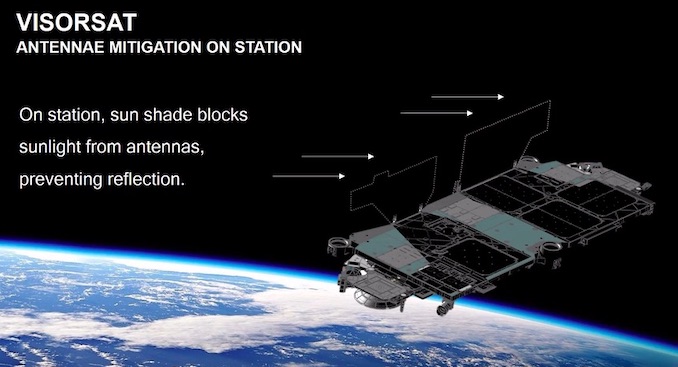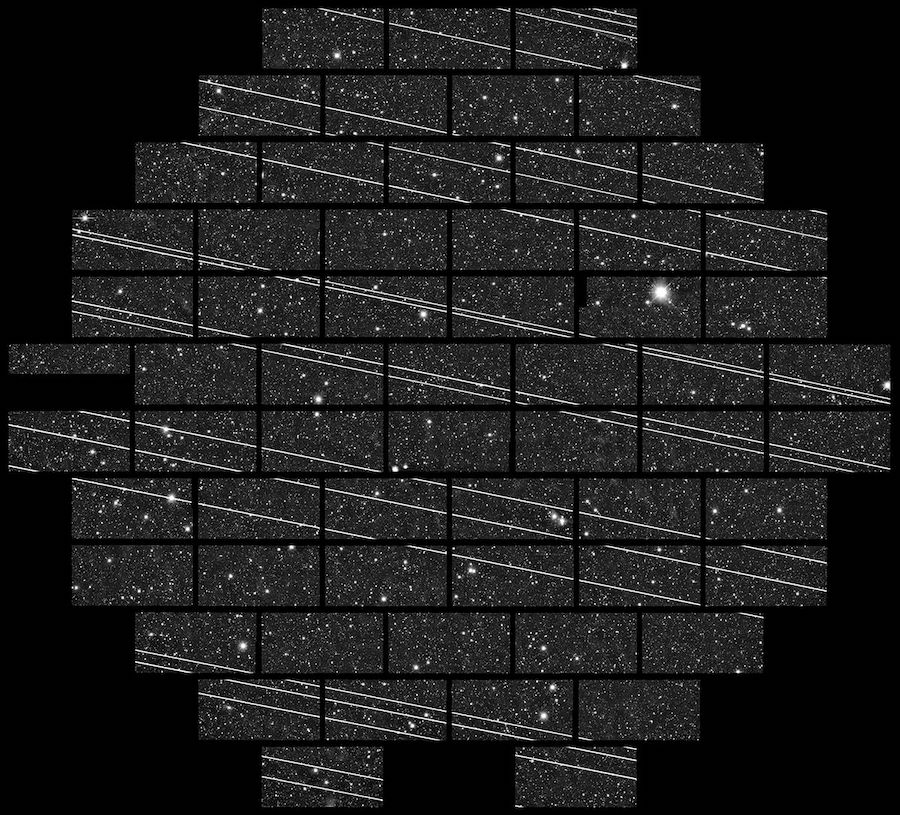
A new sunshade, or visor, designed to reduce the brightness of SpaceX’s Starlink broadband Internet satellites will debut on the company’s next launch, a measure intended to alleviate astronomers’ concerns about impacts on observations through ground-based telescopes, SpaceX founder Elon Musk said.
Beginning with the next launch of Starlink satellites — scheduled for 18 May from Cape Canaveral — SpaceX will try out a new light-blocking panel to make the spacecraft less visible to skywatchers and astronomers.
“We have a radio-transparent foam that will deploy nearly upon the satellite being released (from the rocket),” Musk said on 27 April at a virtual meeting of the National Academies’ Decadal Survey on Astronomy and Astrophysics 2020 panel, a committee charged with setting the top priorities for US astronomy for the next decade.
Musk said the new material will block sunlight from reaching the satellites’ antennas, comparing it to a sun visor in a car’s windshield. Reflected sunlight at dawn and dusk is what makes the satellites visible from the ground.
The sunshade is transparent to radio signals. SpaceX has nicknamed the new Starlink satellite design “VisorSat.”
On seven launches since last May, SpaceX has deployed 420 Starlink satellites to begin building out the Starlink network. The satellites are designed to provide global broadband Internet service, and SpaceX eventually plans to launch thousands of the 245 kg, flat-panel data relay stations to orbits below an altitude of about 570 kilometres (354 miles).
“Using our low orbital altitude and flat satellite geometry to our advantage, we designed an RF-transparent deployable visor for the satellite that blocks the light from reaching most of the satellite body and all of the diffuse parts of the main body,” SpaceX wrote in an update posted on the company’s website this week. “This visor lays flat on the chassis during launch and deploys during satellite separation from Falcon 9. The visor prevents light from reflecting off of the diffuse antennas by blocking the light from reaching the antennas altogether.”
SpaceX says that every future Starlink satellite will be fitted with the sun visor beginning with a subsequent launch in June.
Five Falcon 9 rocket launches so far this year have carried 300 Starlink satellites into orbit — 60 at a time — most recently on 22 April.
The sunshade is the latest change SpaceX has introduced on Starlink satellites in response to complaints from astronomers about the network’s impacts on observations from ground-based telescopes.

The first 60 Starlink satellites launched last May were much brighter than SpaceX or astronomers anticipated, prompting a series of discussions between the aerospace company and the astronomy community.
SpaceX launched a satellite with a darker coating in January, and astronomers noticed an improvement. SpaceX said last month that preliminary data indicated a “notable reduction” in the brightness of that satellite, which has been dubbed “DarkSat.”
“The darkening that they did on DarkSat is about a factor of two-and-a-half fainter — so about 1 magnitude in astronomical units — and it’s still visible to the unaided eye under excellent conditions,” said Pat Seitzer, an astronomer and orbital debris expert at the University of Michigan.. “That is you’re a person with great vision sitting on top of a mountaintop faraway from the city lights.”
But the darker coating has drawbacks, SpaceX said. Black surfaces in space get hot, so the company is moving forward with the sun visor solution instead.
“This avoids thermal issues due to black paint, and is expected to be darker than DarkSat since it will block all light from reaching the white diffuse antennas,” SpaceX said.
The Starlink satellites are brightest soon after a launch, when they are flying at an altitude of around 300 kilometres (200 miles). Once deployed from the Falcon 9 rocket, the spacecraft unfurl their solar array wings to generate electricity, then activate krypton ion thrusters to begin climbing into their higher operational orbit.
SpaceX commands the satellites to fly in a special attitude, or orientation, during the orbit-raising manoeuvres. This minimises drag on the satellites.
“This low-drag and thrusting flight configuration resembles an open book, where the solar array is laid out flat in front of the vehicle,” SpaceX said. “When Starlink satellites are orbit-raising, they roll to a limited extent about the velocity vector for power generation, always keeping the cross sectional area minimized while keeping the antennas facing Earth enough to stay in contact with the ground stations.”

After the satellites reach their operational orbit, SpaceX flies the spacecraft in a different configuration called the “shark-fin” attitude. In this orientation, the solar panel points away from the Earth.
When the satellites are in the “open book” configuration at lower altitudes, sunlight reflects off the craft’s solar arrays, making them more visible from the ground.
The sun visor is designed to reduce brightness while the Starlink satellites are on station at their operational altitude. SpaceX is debuting a different technique to address brightness concerns during the early weeks of each satellite’s life, when the spacecraft are flying closer to Earth.
“We’re taking several steps to reduce brightness in orbit-raising, which has definitely startled a lot of people around the world,” Musk said Monday. “I’ve gotten quite a lot of feedback on that front. So we’re changing the angles. That should be something that happens even this week — the satellites being commanded to a different angle that is less bright.”
“We’re currently testing rolling the satellite so the vector of the Sun is in-plane with the satellite body, i.e. so the satellite is knife-edge to the sun,” SpaceX said. “This would reduce the light reflected onto Earth by reducing the surface area that receives light.”
The new roll manoeuvre can be implemented when the satellites are climbing to higher altitude, and when they pause in an intermediate orbit to align with their operational planes within the Starlink network.
SpaceX said the new “orientation roll” manoeuvre will diminish the amount of power generated by each satellite’s solar panel, and reduce contact time between the spacecraft and ground controllers. The change also points star tracker cameras at the Earth and the Sun, reducing the satellite’s attitude knowledge, according to SpaceX.
“There will be a small percentage of instances when the satellites cannot roll all the way to true knife edge to the Sun due to one of the aforementioned constraints,” SpaceX said. “This could result in the occasional set of Starlink satellites in the orbit raise of flight that are temporarily visible for one part of an orbit.”
Musk described the changes as “quite simple.”
“I think, with the benefit of hindsight, the changes seem quite simple, which is to make sure that the orientation of the satellites is not such that we’re reflecting the Sun,” he said. “And to either darken the specular surfaces or the white surfaces, or shade them, is really quite simple actually. It’s a little bit silly in hindsight. It’s not that hard.
“Our objectives, generally, are to make the satellites invisible to the naked eye within a week, and to minimise the impact on astronomy, especially so that we do not saturate observatory detectors and inhibit discoveries,” Musk said.

The satellites that launched without the brightness mitigations will likely be retired and will re-enter the atmosphere and burn up within three or four years, Musk said. They will be replaced with improved satellites.
SpaceX has regulatory approval from the Federal Communications Commission to eventually field a fleet of up to 12,000 small Starlink broadband stations.
Officials say 24 launches are needed to provide global broadband service through the Starlink service. But the company could provide an interim level of service over parts of the Earth — such as Canada and northern parts of the United States — later this year, once SpaceX has launched around 720 satellites on 12 Falcon 9 flights.
Musk tweeted last week that SpaceX aims to begin private “beta testing” of the Starlink service within about three months, followed by a public trial period in six months.
SpaceX has modified the architecture of the Starlink network several times. Most recently, SpaceX submitted an application to the Federal Communication Commission on Friday proposing to operate more satellites in lower orbits than the FCC previously authorized.
Rather than launching more than 2,800 of the Starlink satellites to higher orbits between 1,110 and 1,325 kilometres (690 miles and 823 miles) in altitude, SpaceX will instead deploy the spacecraft closer to Earth. The change allows the network to provide consumers with better internet service, and also reduces the number of Starlink satellites that might be visible in the sky at any one time.
“We think, for a lot of reasons, that 550 (kilometres) and below is the right approach for a LEO (Low Earth Orbit) broadband situation,” Musk said. “Your data rate is going to be four times better than say at 1,100 kilometres. That’s a close approximation. It’s also better for astronomy.”
The lower orbit also ensures atmospheric drag will cause dead satellites to re-enter the atmosphere more quickly, SpaceX said.

Musk said 20,000 to 30,000 Starlink satellites may be needed to provide the level of Internet service envisioned by SpaceX, which aims to provide connectivity to the “3 or 4 percent of the least-served portion of the Earth.”
“So it’s not a huge percentage, but it’s for those that have the least service,” Musk said Monday. “You do want to have probably on the order of 20,000 to 30,000 satellites, something like that. But not 200,000, I don’t think.”
SpaceX has filed documentation with the International Telecommunication Union for up to 30,000 additional Starlink satellites beyond the 12,000 spacecraft already authorized by the FCC.
It’s the large number of Internet satellites planned by SpaceX and other companies, such as Amazon, that worries astronomers.
“SpaceX is committed to the progress of science, both in the United States and elsewhere,” Musk said. “So we’ll do our best to ensure that we’re not going to interfere with any facilities anywhere in the world.”
One of the ground-based facilities most at risk of interference from the Starlink satellites is the US government-funded Vera Rubin Observatory, formerly known as the Large Synoptic Survey Telescope. The observatory under construction in Chile will capture deep, wide-field images of the entire southern sky, allowing astronomers to learn more about dark energy and dark matter, and detect potentially hazardous asteroids with orbits near Earth, among other objectives.
Steve Kahn, director of the Vera Rubin Observatory, said last week that SpaceX is responsive to astronomers’ concerns.
“They’ve been quite cooperative in working with us,” Kahn told Spaceflight Now in an interview.
Scientists will measure the brightness of the new VisorSat spacecraft after launch to gauge the effectiveness of the sunshade. If it works as advertised, the sun visor could limit the impacts of the Starlink satellites on the Vera Rubin Observatory.
Musk pitches astronomers on Starship’s ability to launch giant space telescopes
Toward the end of Monday’s virtual meeting, Musk expressed interest in building and launching a new space-based observatory using SpaceX’s next-generation Starship launch vehicle.
“I’d be pretty interested in trying to figure out how to help launch and possibly build a big satellite, a big observatory in space,” Musk said. “Maybe … we can get together and talk about what would be a really exciting space observatory, like a planet imager or something like that.”
The decadal survey panel was chartered to prioritize which space-based observatories NASA should pursue after the launch of the James Webb Space Telescope and the Wide Field Infrared Survey Telescope.
“I’m really interested in the advancement of science, and to understand what the heck is going on in this universe,” Musk said.
SpaceX says from the Starlink Internet business will help fund development of the Starship. When coupled with a new first stage booster SpaceX calls the Super Heavy, the Starship will be able to loft more than 100 metric tonnes, or 220,000 pounds, of cargo to low Earth orbit.
“Starship has the capability to transport satellites, payloads, crew, and cargo to a variety of orbits and Earth, lunar, or Martian landing sites,” SpaceX wrote in a Starship user’s guide released last month.
The Starship’s payload envelope is also significantly larger than any other existing rocket. Its diameter will measure around nine metres (30 feet), allowing the Starship to launch big telescopes without requiring the mirrors be folded to fit inside a payload fairing.
“The launch situation has changed quite dramatically from where it was in 2010,” Musk said. “It will be very much changed, I think, in even five years. I think Starship … will be flying quite soon. I think you’ll see regular flights within a couple of years, and that’s a very big rocket.
“It allows for space telescopes to be at least transported to orbit at probably an order of magnitude lower cost than in the past,” Musk said. “So that’s pretty important to factor into future plans.”
Email the author.
Follow Stephen Clark on Twitter: @StephenClark1.



